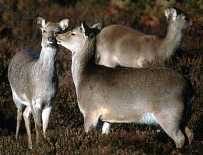
The future of Scotland's wild deer
By David Ross in the Herald 31 st October 2000
 THE Deer Commission for Scotland yesterday published its
vision for the next two decades for the estimated 600,000 wild deer who roam
our hills and forests, owned by no-one until they are killed or captured.
THE Deer Commission for Scotland yesterday published its
vision for the next two decades for the estimated 600,000 wild deer who roam
our hills and forests, owned by no-one until they are killed or captured.
Wild deer are currently seen by some as providing great vital economic benefits through deer management and venison production; and by others as the source of significant damage to our natural heritage, agriculture, and forestry.
The vision, which tries to balance the historically conflicting demands of environmentalists seeking more stringent controls of deer levels and sporting estates resisting them, sets no culling targets. These are to be agreed locally so that deer management can be fully integrated with all other local land uses and objectives.
But it is clear more red deer will have to be shot, and if local voluntary agreements fail the Commission has the legal power to ensure the necessary reductions are achieved. Each year some 100,000 deer are legally shot in Scotland, about two-thirds are red deer. Many of them are on the two hundred private sporting estates, but the largest single cull is by the Forestry Commission. It is estimated that the present red deer population stands around 350,000 but despite a record cull of more than 70,000 in 1998/99, it is still increasing.
There are thought to be 200,000 roe deer in Scotland with an annual cull of around 40,000. There are no reliable estimates for Sika deer, although some 4000 were culled last year, while the population of fallow deer is not thought to exceed 8000. Despite some reports, muntjac deer have not been confirmed as living wild in Scotland.
Commission chairman Andrew Raven said that there was a growing consensus that deer management should be integrated with other land uses, and added: "In general terms, a reduction in deer numbers is envisaged. This should benefit agriculture, forestry and the natural heritage, improve habitats for deer and other species, and enhance economic benefits locally and nationally."
Rural Affairs Minister Ross Finnie welcomed the vision statement as did Simon Pepper, Scottish director of the World Wide Fund for Nature who thought it had brought together all the interests, environmentalists like himself and the sporting estates.
A spokesman for the Scottish Landowners, said: "The SLF had been seeking future management of wild deer to be agreed on a local basis and handled through existing networks to ensure representation of those with a justified interests." The SLF was pleased a partnership between the different bodies was being formed.
The Commission's vision for wild deer holds that in two decades: "Scotland will have the same four species of wild deer as at present. No significant colonisation by muntjac will have occurred. Roe deer will still be distributed throughout Scotland.
"The expansion in the range of red deer will largely have ended. A growing proportion of the overall red deer population will live in woodlands or use woodlands for much of the year . . . Sika will not have spread throughout Scotland and they will generally be restricted to woodland populations, and excluded so far as possible from the open range. There will have been little, if any, expansion in the range of the localised populations of fallow deer and in some cases, a reduction. Deer will occupy land of a higher ecological value than at present."
- Oct 31
© The Herald, 31 st October 2000
 |
 |
 |
| Return to index | Return to Exotic Scottish Animals | Return to Sika Deer |